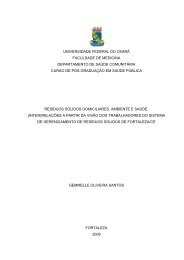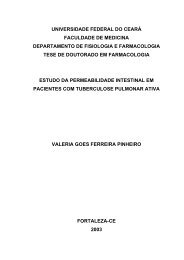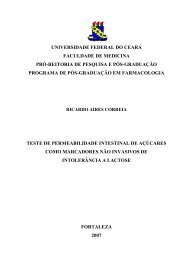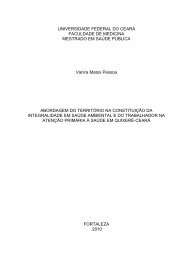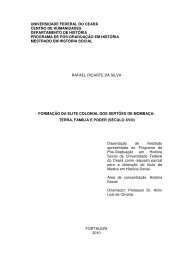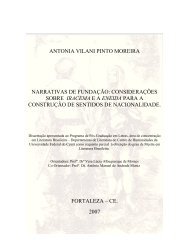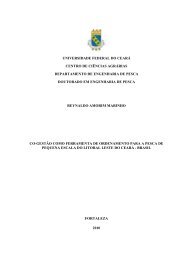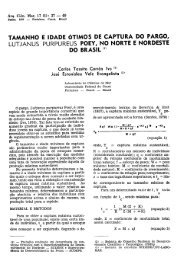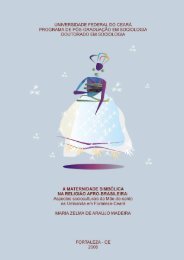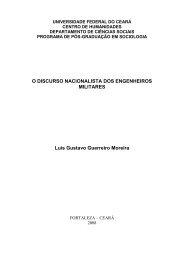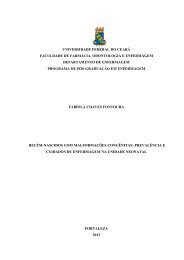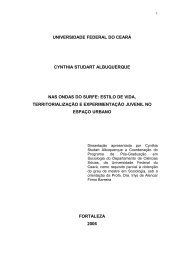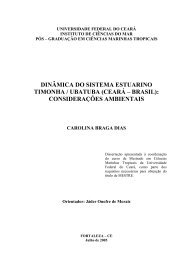Tungíase: doença negligenciada causando patologia grave
Tungíase: doença negligenciada causando patologia grave
Tungíase: doença negligenciada causando patologia grave
Create successful ePaper yourself
Turn your PDF publications into a flip-book with our unique Google optimized e-Paper software.
Figure 3. Multiple lesions on the left heel of a 13 year-old<br />
Brazilian girl.<br />
doi:10.1371/journal.pntd.0000087.g003<br />
In the multivariate logistic regression analysis, pigs on the<br />
compounds (adjusted OR = 18.0) and sandy floors inside houses<br />
(adjusted OR = 9.3) were the most important independent risk<br />
factors for infestation (Table 2). After controlling for confounding,<br />
the type of house was not an independent risk factor for infestation.<br />
Other modifiable factors independently associated with tungiasis<br />
included the resting place commonly used and the presence of cats.<br />
Individuals living in families that use regularly insecticides indoors<br />
had a lower chance to be infested. The regular use of closed footwear<br />
was also an independent protective factor (Table 2).<br />
The population attributable fractions for modifiable variables<br />
associated with tungiasis were: sand or clay floor inside the house<br />
(73.7%), resting commonly outside the house (65.5%), no regular<br />
use of closed footwear (51.1%), and pigs on the compound (37.9%;<br />
Table 3).<br />
Discussion<br />
Our data show that in Erekiti, a typical community in Western<br />
Nigeria with endemic tungiasis, several factors were independently<br />
associated with infestation by Tunga penetrans. In particular, sandy<br />
floor inside the house, behaviour (such as the common resting<br />
place and the use of closed footwear), as well as the presence of<br />
pigs on the compound contributed to an important extent to a high<br />
prevalence of tungiasis in the community. We identified the use of<br />
insecticides indoors and the use of soap, as well as the type of water<br />
supply as protective factors. In addition, the younger and older age<br />
groups were described as being most vulnerable for infestation.<br />
So far, there is only one other study focussing on risk factors for<br />
tungiasis; this study was done in a poor fishing community in<br />
Brazil [16]. The importance of housing for the transmission<br />
dynamics has also been described in the Brazilian study. There,<br />
living in a house built on dunes, living in a house made of palm<br />
products, and having a floor of sand or clay inside the house were<br />
important risk factors for infestation in the multivariate analysis;<br />
adjusted odds ratios for these variables ranged from 1.9 to 4.7 [16].<br />
Interestingly, in Nigeria the type of house was not an independent<br />
factor predisposing for infestation, but confounded by the type of<br />
floor inside the house and other factors. Thus, after controlling for<br />
confounding, the type of house per se did not predict infestation in<br />
Erekiti.<br />
The findings of the present study corroborate our hypothesis<br />
made several years ago that the flea prefers sandy soil and shade for<br />
breeding and that, as an intervention, floors of houses could be<br />
Tungiasis in Nigeria<br />
cemented and streets paved [19]. This hypothesis is also confirmed<br />
by our finding that the resting place, which is commonly underneath<br />
a shady tree, is an important factor associated with infestation. We<br />
speculate that these places are preferred breeding sites of the flea, as<br />
there is abundant organic material for the larvae to feed on.<br />
It is known that the animal reservoir plays an important role for<br />
transmission dynamics in endemic communities [20]. In particular,<br />
dogs, cats and rats have been described to be commonly<br />
infested [20–22], and several authors reported severe disease in<br />
pigs from different African countries, such as from São Tomé e<br />
Príncipe, Zaire, Cameroon and Tanzania [12,23–26]. These<br />
studies emphasized the importance of pigs as animal reservoir of<br />
T. penetrans. Our data suggest that the presence of pigs on a family<br />
compound is an important predictor for human tungiasis and that<br />
pigs may be the most important animal reservoir this Nigerian<br />
community. Although we did not perform a formal prevalence<br />
study on domestic animals, we observed severely infested pigs in<br />
the community (Ugbomoiko, unpublished observation). Pigs did<br />
not play a role for transmission in Brazil, as in the studied<br />
community free-roaming pigs were absent [16]. Interestingly, in<br />
Brazil a significant reduction of attack rates in humans has been<br />
observed after the prohibition to let pigs roam freely in the<br />
community [19]. Similar intervention measures in Erekiti would<br />
probably reduce the prevalence of tungiasis in the community<br />
significantly. In contrast to the Brazilian study, we did not identify<br />
dogs, but cats to increase the prevalence in the community. In<br />
Brazil, dogs are commonly infested with prevalences reaching<br />
67.0% in an urban slum [27].<br />
The higher prevalence in children and the elderly in Erekiti is<br />
probably due to higher exposure and different disease-related<br />
behavior. Children play around (mostly barefooted) in the<br />
community, and the elderly have more difficulties to take out<br />
embedded fleas than young people. We observed in the<br />
community that skilful older children carry out flea extraction<br />
for their friends and younger children at school and that such<br />
assistance is rarely rendered to less skilful, poor sighted elder<br />
people [13].<br />
We did not find any significant gender differences to predispose<br />
for infestation. Gender differences seem to differ from community<br />
to community. Whereas in some study areas, the male sex seems to<br />
be more vulnerable for tungiasis, in other areas, the females are<br />
more prone to infestation, or no gender differences have been<br />
observed [21,28–32]. Thus, we speculate that gender differences<br />
are, similar to age, related to different exposure and disease-related<br />
behavior.<br />
The use of proper footwear may decrease the prevalence in<br />
a community. According to our data, a consistent use of footwear<br />
would reduce infestation rates by about the half. However,<br />
economical, behavioural and cultural constraints may prohibit the<br />
intensive use of closed footwear in endemic communities in<br />
Western Africa.<br />
Other socio-economic and behavioural factors found in this<br />
study, such as illiteracy, the type of water supply, and the use of<br />
soap, may be explained by an indirect relationship with tungiasis.<br />
For example, families with better access to water and using soap<br />
are prone to better hygiene standards. In addition, tungiasis can be<br />
regarded as a poverty-associated disease [1,19], and improving<br />
sanitation and waste collection have been discussed as factors to<br />
reduce the incidence of tungiasis [19]. However, the effectiveness<br />
of these measures is difficult to predict, and they are more costly<br />
than cementing floors of houses, confining pigs to pigpens, and<br />
realizing health education.<br />
Similar to our results, the use of insecticides inside houses has<br />
been described as a protective factor in the Brazilian study. This<br />
PLoS Neglected Tropical Diseases | www.plosntds.org 4 2007 | Volume 1 | Issue 3 | e87



